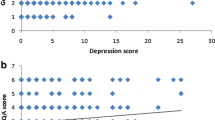Abstract
Background: It is known that psychological factors can affect end points of surgical treatment. The current study aimed to evaluate the outcome of laparoscopic antireflux surgery (LARS) in patients with gastroesophageal reflux disease (GERD) who experience concomitant major depression in comparison with GERD patients who have no known comorbidity. Methods: Among a sample of more than 550 patients who underwent LARS, a group of 38 GERD patients with concomitant major depression (MD) were included in this study. The patients included 24 women and 14 men, with a mean age of 51 years. A group of 38 control patients (non-MD) matched in terms of age, gender, and esophageal manometry findings was selected from the database for comparison of surgical outcomes between patients with GERD accompanied by concomitant major depression and GERD patients with no known comorbidity. In each group, 23 patients received a Toupet fundoplication and 15 patients underwent a "floppy" Nissen fundoplication. The following factors were evaluated before surgery, 3 months afterward, and 1 year after LARS: symptoms (heartburn, regurgitation, chest pain, bloating, and dysphagia), quality of life (Gastrointestinal Quality of Life Index [GIQLI]), lower esophageal sphincter pressure (LESP), and 24-h pH monitoring (DeMeester score). Results: Before and after surgery, there were no significant differences between the two groups in terms of LESP and DeMeester score. Preoperative GIQLI showed significant differences (p < 0.05) between the two groups (MD group, 71.8 ± 8.6 vs non-MD group, 91.1 ± 9.8), and significant differences (p < 0.01–0.001) between the mean data and that for healthy individuals (122.6 ± 8.5). The GIQLI scores had improved significantly at 3 months and at 1 year after surgery (p < 0.05–0.001) in all the patients (1 year postoperatively: MD group, 99.3 ± 8.6 vs non-MD group, 121.9 ± 9.7). Before surgery, when symptoms were compared between the two groups, significant differences (p < 0.001) were found in the percentage of chest pain (81.6% vs 37.4%) and bloating (92.2% vs 37.4%), showing that these symptoms were more predominant and graded as much more severe among patients with MD. In both groups, all the symptoms but dysphagia showed a significant improvement in severity (p < 0.05–0.0001). A comparison of both groups postoperatively showed that significant differences were still present in chest pain (44.7% vs 2.6%), bloating (68.4% vs 18.4), and dysphagia (50.1% vs 2.6%). A significant difference (p < 0.001) was observed only in patients with major depression and depending on the kind of wrap procedure (Nissen vs Toupet), showing that dysphagia (78.9% vs 21.1%) and chest pain (82.4% vs 17.6%) were much more predominant in patients who underwent "floppy" Nissen fundoplication. Conclusions: Even if they are good surgical candidates from a physiologic point of view, GERD patients with concomitant major depression should be selected carefully. In these patients, LARS can normalize physiologic data, but some patients have demonstrated less symptomatic relief, suffered from postoperative dysphagia, and showed less quality-of-life improvement. Eventually, laparoscopic Toupet fundoplication used with these patients could result in a better subjective outcome.
Similar content being viewed by others
Author information
Authors and Affiliations
Rights and permissions
About this article
Cite this article
Kamolz, T., Granderath, F. & Pointner, R. Does major depression in patients with gastroesophageal reflux disease affect the outcome of laparoscopic antireflux surgery?. Surg Endosc 17, 55–60 (2003). https://doi.org/10.1007/s00464-002-8504-8
Received:
Accepted:
Published:
Issue Date:
DOI: https://doi.org/10.1007/s00464-002-8504-8




